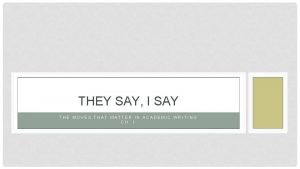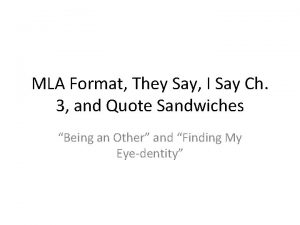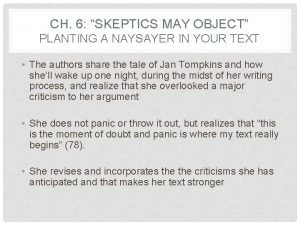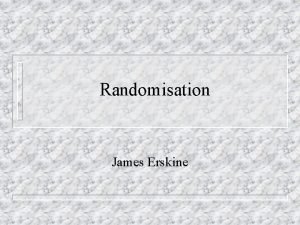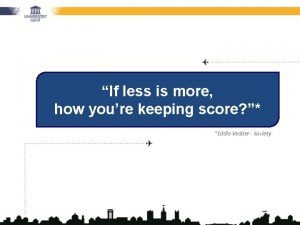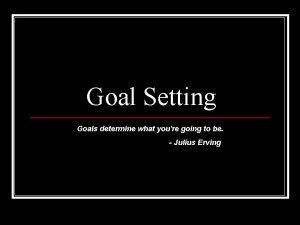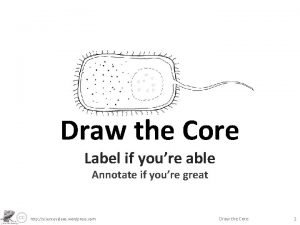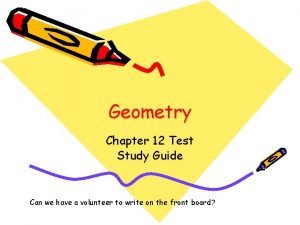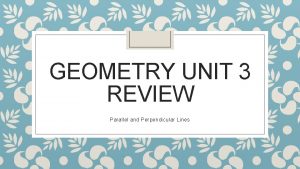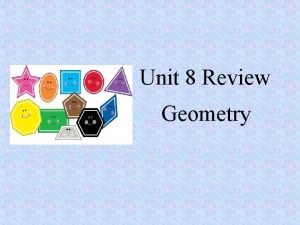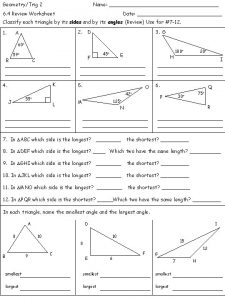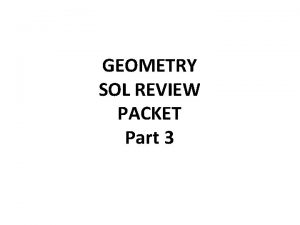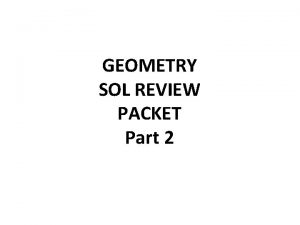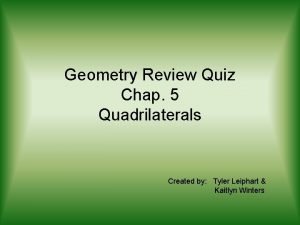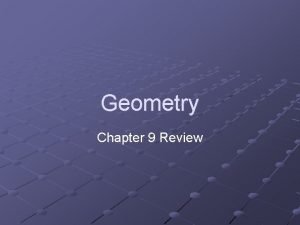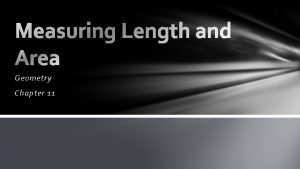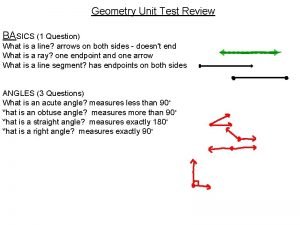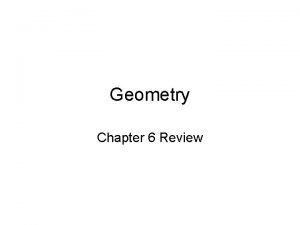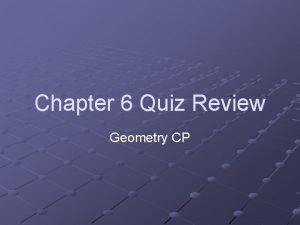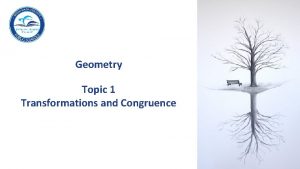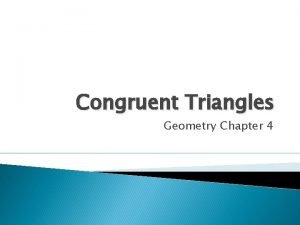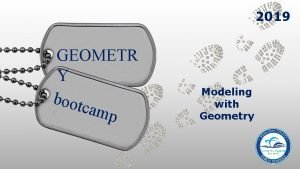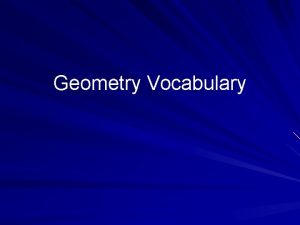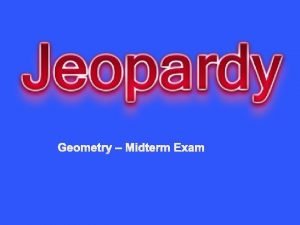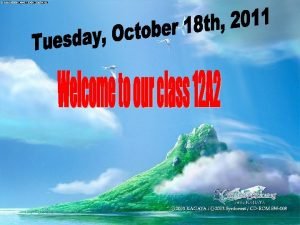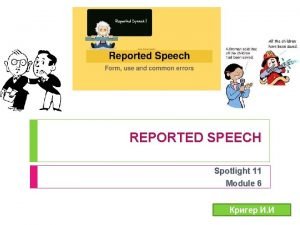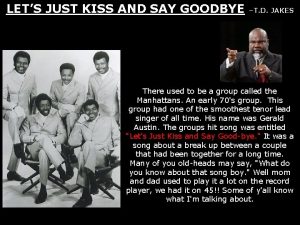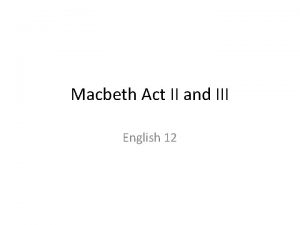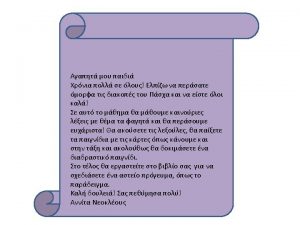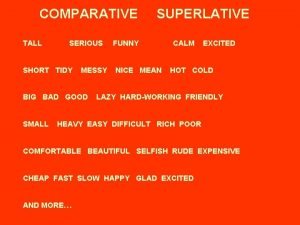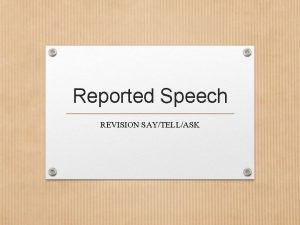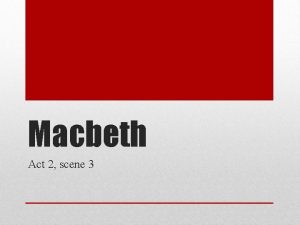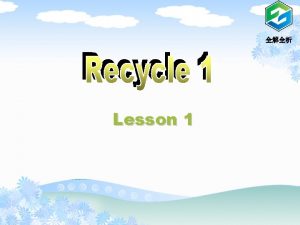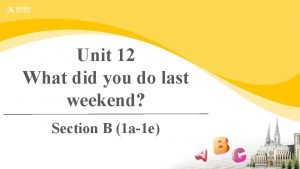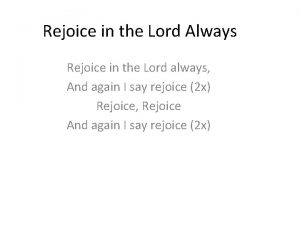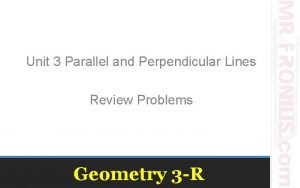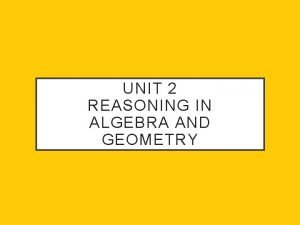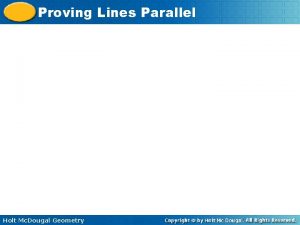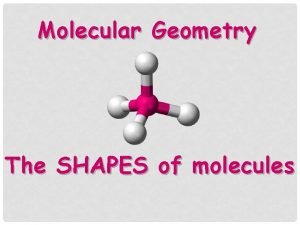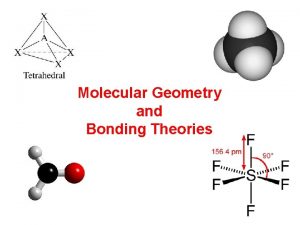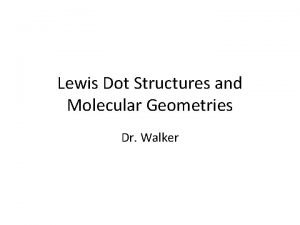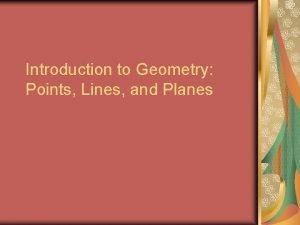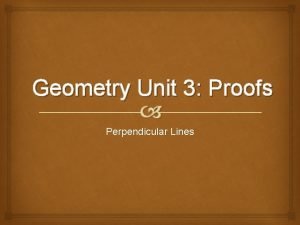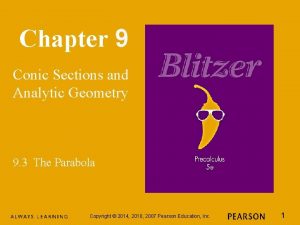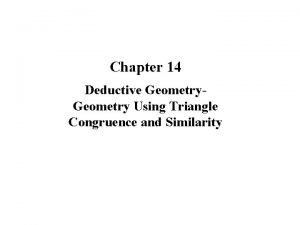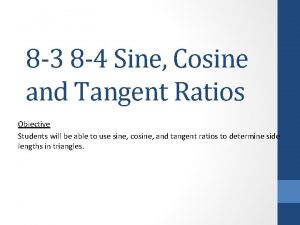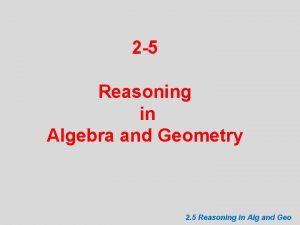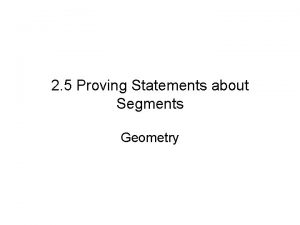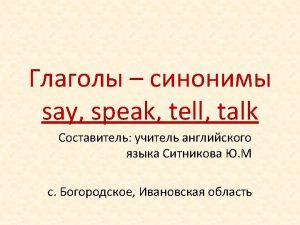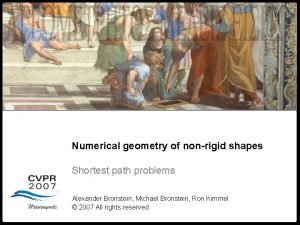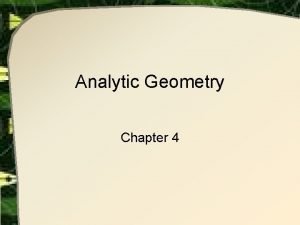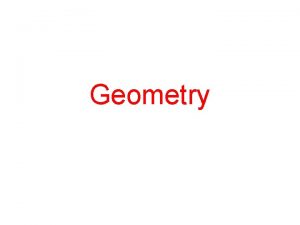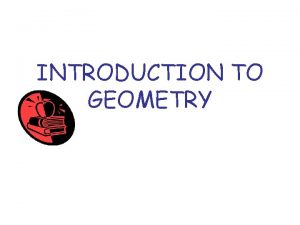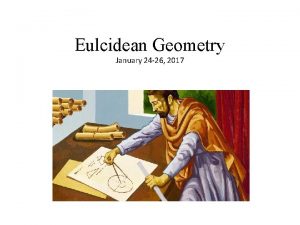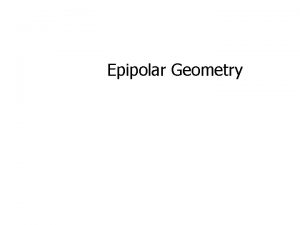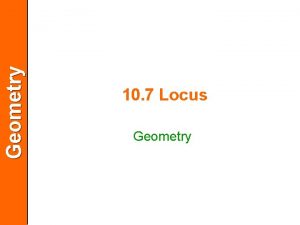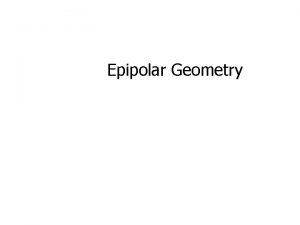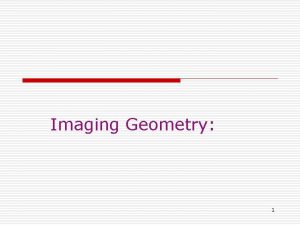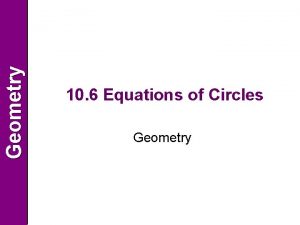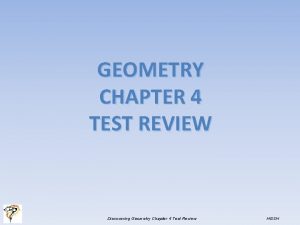Geometry Review Say youre me and youre in
































































































- Slides: 96

Geometry Review “Say you’re me and you’re in math class…. ” Geometry Cohort Weston Middle School June 2013

Definitions • • Point— 0 Dimensions- P Line Segment AB Midpoint Ray

Definitions • 2 Co-linear Points define a line • 2 intersecting lines define a plane

Circle Definitions • • Circle Radius Chord- 2 points on a circle Secant- line through 2 points Diameter Tangent Major Arc, Minor Arc

Angles • • 2 rays form angle Vertex, Sides Adjacent Angles-share a side Acute Angle- < 90 Right Angles Obtuse Angles> 90 Straight angle= 180 Reflex Angle > 180

Angles-2 • • Lines that intersect form Vertical angles are equal Supplementary angles add up to 180 Complementary angles add up to 90

Parallel Lines and Transversals

Triangle Types

Triangles-1 • 3 points connected with line segments form triangle • Sum of interior angles= 180 degrees • Exterior angle = sum of its remote interior angles

Congruent Triangles Two figures are congruent if they can sit on top of each other

Congruent Triangles

Perimeter, Area • Perimeter= measurement around • Area

Rectangle- 4 right angles, opposite sides equal Right Triangle- has 2 legs and a hypotenuse Area of right triangle= ½ product of legs

Similarity • Two figures are similar if one is simply a blown -up/rotated version of the other

Similar Triangles

Similar Triangles

Right Triangles


Pythagorean Formula

Similar Triangles b/d= a/e= (d+e)/b

30 -60 -90 Triangle, Equilateral Triangle

Similar Triangles

Pythagorean Triples • Set of three integers that satisfy the Pythagorean Theorem Plimpton Tablet 1900 B. C. E.

Heron’s Formula

Angle Bisectors

Angle Bisectors of a triangle are concurrent!

Perpendicular Bisectors

Euler Line

Altitudes

Medians

Length of a median • If the length of a median is ½ the length of the side to which it is drawn, the triangle must be a right triangle. Moreover, the side to which it is drawn is the hypotenuse

Quadrilaterals- Interior angles = 360 degrees. Alternative 1: Trapezoids have 1 pair of parallel sides

Quadrilaterals- Alternative Arrangement- Trapezoids have at least one pair of parallel sides

Trapezoids • ( At least? )Two sides are parallel • Median= Average of the bases • Area= Height x median

Parallelograms • Both pairs of opposite sides equal • Opposite Angles Equal, consecutive angles supplementary • Diagonals Bisect each other

Rhombus • All sides Equal • Diagonals Perpendicular • Area= half the product of diagonals

Kite Definition: A kite is a quadrilateral with two distinct pairs of adjacent sides that are congruent.

Rectangle All angles are 90 degrees Area= l x w Diagonals= sqrt ( l^2 * w^2)

Square • All sides equal, all angles equal (90 degrees) • Diagonal= side*sqrt 2

Cyclic Quadrilaterals each exterior angle is equal to the opposite interior angle. Sum of opposite angles= 180 degrees

Brahmagupta’s Formula

If and Only If • Proving ‘If and Only If’ statements requires proving two different statements “A month has less than thirty days if and only if the month is February” To prove a statement true you must have a proof that covers all possibilities. To prove a statement false, you only have to show one counter-example. Do not assume what you are trying to prove as part of a proof.

Related Conditionals • If the figure is a rhombus, then it is a parallelogram; converse is false

Polygons

Angles in a Polygon

Area of a Regular Polygon • Area= ½ x perimeter x apothem( distance from center to a side)

Geometric Inequalities

Geometric Inequalities • When facing problems involving lengths of altitudes of a triangle, consider using area as a tool.

Funky Areas

Funky Areas

Circles

Circles

Chords of a Circle If chords of a circle are equal in length, they subtend equal arcs

Area of a Sector

Thale’s Theorem • Any Angle Inscribed in a semicircle is a right angle (Thale’s Theorem)

Circle Angles

Inscribed Angles The measure of an inscribed angle is ½ the arc it intercepts

Inscribed Angles Any two angles inscribed in the same arc are equal

Intersecting Chords

Tangents A Tangent Line is perpendicular to a radius

Tangent Chords

Secant-Secant Chords

Secant-Secant Chords

Two tangents are equal! • Hat Rule:

Power of a Point Theorem: Suppose a line through a point P intersects a circle in two points, U and V. For all such lines, the product PU* PV is a constant.

Power of a Point

Planes • Three non-collinear points determine a plane • Dihedral Angle: angle between the planes


Prisms Volume = base x height

3 -D Figures

Cube

Pyramid Volume = 1/3 *area of base*height Lateral Surface Area= ½ Perimeter*slant height

Cylinders

Cones Volume = 1/3 * pi*r^2*h LSA= pi*r*s

Spheres

Transformations

Translations A translation "slides" an object a fixed distance in a given direction. The original object and its translation have the same shape and size, and they face in the same direction. A translation creates a figure that is congruent with the original figure and preserves distance (length) and orientation (lettering order). A translation is a direct isometry.

Translations T (x, y)

Rotations • A rotation is a transformation that turns a figure about a fixed point called the center of rotation. Rays drawn from the center of rotation to a point and its image form an angle called the angle of rotation. (notation Rdegrees )

Rotations R (x, y)

Reflections • A reflection over a line k (notation rk) is a transformation in which each point of the original figure (pre-image) has an image that is the same distance from the line of reflection as the original point but is on the opposite side of the line. Remember that a reflection is a flip. Under a reflection, the figure does not change size. The line of reflection is the perpendicular bisector of the segment joining every point and its image.

Reflections r(x, y)

Glide Reflections Reflection over a line + translation

Dilations

Dilations Dk(x, y)

Compositions- Done in order from right to left

Analytic Geometry

Analytic Geometry

Analytic Geometry The product of slopes of perpendicular lines is -1 If two lines have the same slope, they are parallel

Circle Equations

Trigonometry

Trigonometry sin A= cos( 90 -A)

Law of Cosines

Law of Sines

Missing Lines • The key to many problems is drawing the magic missing line • Segments that stop inside figures should be extended • Label lengths as you find them • If you see 30, 60, or 90 degree angles- buildm 30 -60 -90 degree triangles • When in doubt, build right triangles

Good Luck!
 Gerald graff they say i say
Gerald graff they say i say Pf3 number of vsepr electron groups
Pf3 number of vsepr electron groups They say, i say examples
They say, i say examples Metacommentary example
Metacommentary example They say i say quotation sandwich
They say i say quotation sandwich It's not what you say it's how you say it
It's not what you say it's how you say it 6 paragraph essay
6 paragraph essay They say / i say paragraph examples
They say / i say paragraph examples What are voice markers they say i say
What are voice markers they say i say They say i say the moves that matter
They say i say the moves that matter Quote sandwich examples
Quote sandwich examples Skeptics may object summary
Skeptics may object summary They say i say moves that matter in academic writing
They say i say moves that matter in academic writing Ikilik say sistemi əlifbası
Ikilik say sistemi əlifbası They say i say chapter 10
They say i say chapter 10 They say i say thesis statements
They say i say thesis statements Some say the world will end in fire some say in ice
Some say the world will end in fire some say in ice Some say the world will end in fire some say in ice
Some say the world will end in fire some say in ice What do you say after you say hello
What do you say after you say hello They say i say
They say i say 4 electron domains 2 lone pairs
4 electron domains 2 lone pairs Bonding theories
Bonding theories Writing a mail
Writing a mail What to do when you're angry
What to do when you're angry Good afternoon everyone
Good afternoon everyone My hope and firm foundation
My hope and firm foundation Tlri generator services
Tlri generator services Your grace, my master
Your grace, my master I dont know where youre going
I dont know where youre going How do you know if you're asexual
How do you know if you're asexual Love and hate poem
Love and hate poem If less is more how you keeping score
If less is more how you keeping score Youre goals
Youre goals Draw a diagram and add annotated labels
Draw a diagram and add annotated labels And the tree was happy
And the tree was happy Geometry chapter 12 study guide answers
Geometry chapter 12 study guide answers Geometry unit 3 parallel and perpendicular lines
Geometry unit 3 parallel and perpendicular lines Geometry unit 8 test
Geometry unit 8 test Geometry review worksheet
Geometry review worksheet Chemistry sol review packet
Chemistry sol review packet Geometry sol review packet
Geometry sol review packet Geometry review quiz 5
Geometry review quiz 5 Geometry chapter 9 review
Geometry chapter 9 review Chapter 11 circles geometry answer key
Chapter 11 circles geometry answer key Geometry unit 1 review
Geometry unit 1 review Definition of a circle in geometry
Definition of a circle in geometry Unit test review geometry
Unit test review geometry Classify each statement as true or false.
Classify each statement as true or false. Chapter 6 quiz 1 geometry
Chapter 6 quiz 1 geometry Transformations and congruence
Transformations and congruence Geometry chapter 4 proving triangle congruence
Geometry chapter 4 proving triangle congruence Geometry bootcamp
Geometry bootcamp Obtues angle
Obtues angle Bisexts
Bisexts Chapter review motion part a vocabulary review answer key
Chapter review motion part a vocabulary review answer key Ap gov review final exam review
Ap gov review final exam review Narrative review vs systematic review
Narrative review vs systematic review What is inclusion and exclusion
What is inclusion and exclusion Narrative review vs systematic review
Narrative review vs systematic review Look at the pictures and say what their jobs are
Look at the pictures and say what their jobs are Module 2 reported speech
Module 2 reported speech Look at these pictures
Look at these pictures Look at the photo answer the questions
Look at the photo answer the questions Listen and say
Listen and say Let's just kiss and say goodbye
Let's just kiss and say goodbye What does jesus say about war and peace
What does jesus say about war and peace 3 read and choose
3 read and choose Comic relief in macbeth act 1
Comic relief in macbeth act 1 Listen point and say
Listen point and say Slip out of abstraction
Slip out of abstraction Superlative form funny
Superlative form funny Look at the picture.say and guess
Look at the picture.say and guess Trace colour and say
Trace colour and say Reported speech before
Reported speech before Some say the earth was feverous and did shake
Some say the earth was feverous and did shake Listen and circle the numbers you hear
Listen and circle the numbers you hear A lion laughing
A lion laughing Whos ghost does macbeth see
Whos ghost does macbeth see Where has macduff gone and why
Where has macduff gone and why Look and draw. say
Look and draw. say What did your partner do last weekend
What did your partner do last weekend Teach a parrot to say supply and demand
Teach a parrot to say supply and demand Rejoice in the lord always and again i say, rejoice
Rejoice in the lord always and again i say, rejoice Unit 3 test parallel and perpendicular lines
Unit 3 test parallel and perpendicular lines Property of congruence
Property of congruence Holtmc
Holtmc Axe notation examples
Axe notation examples Molecular geometry and bonding theories
Molecular geometry and bonding theories I3- point group
I3- point group Introduction to geometry points lines and planes
Introduction to geometry points lines and planes Geometry statements and reasons
Geometry statements and reasons Chapter 9 conic sections and analytic geometry
Chapter 9 conic sections and analytic geometry Deductive geometry reasons
Deductive geometry reasons Monor arc
Monor arc Sine cosine tangent
Sine cosine tangent 2-5 practice reasoning in algebra and geometry
2-5 practice reasoning in algebra and geometry Geometry statements and reasons
Geometry statements and reasons


